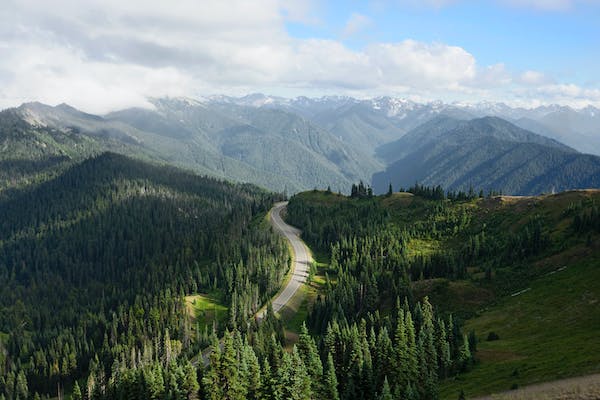This national park located north-west of the Washington State boasts its scenic lakes, spectacular coastline, majestic mountains and glaciers, and a magnificent virgin temperate rainforest. It is also renowned for its geological formations such as the rocky islets, formed by a continuously receding and changing coastline, deep canyons, and valleys formed by erosion and jagged peaks and beautiful cirques sculpted by glaciation. The area houses extensive alpine meadows surrounded by a broad old-growth forest, among which is the best example of an intact and protected temperate rainforest in the Pacific Northwest.
The park has the lowest latitude in the world in which glaciers form below an elevation of 2000 meters and occur below an altitude of 1000 meters. With relative isolation, high rainfall, and strong west-to-east precipitation gradient, many watersheds and rugged topography have combined and created various and complex habitats. Therefore, the park is rich in biological diversity and has a high rate of endemism.
Eleven significant rivers in the park are some of the best habitats for anadromous fish species in the US. Also included in the park is 100 km of wilderness coastline, which is the longest undeveloped coast in the country and is rich in native and endemic animal and plant species.
History of the Park
There were eight contemporary tribes of the Olympic Peninsula have lived in the area since ancient time and continue to maintain strong relationships to the lands and waters now within Olympic National Park. The tribes include the Makah, Quileute, Hoh, Quinault, Skokomish, Port Gamble S’Klallam, Jamestown S’Klallam, and Lower Elwha Klallam.
In response to the disappearing forests, President Grover Cleveland designated the area as Olympic Forest Reserve in 1897. After eight years, in 1909, President Teddy Roosevelt designated a part of the reserve as Mount Olympus National Monument to protect the habitat of Roosevelt Elk, whose population was declining tremendously.
In 1938, the area was re-designated at Olympic National Park by President Franklin Roosevelt. It became an International Biosphere Reserve in 1976, and a World Heritage Site in 1981, in recognition of its exceptional natural beauty and outstanding diversity of plants and animals.
Engraved and in the park’s diverse landscape is an array of cultural and historical sites that convey the park’s human story. Human settlement about 12 000 years is documented in more than 650 archeological sites in Olympic National Park lands. Historic sites hint the 200-year history of exploration, homesteading, and the development of the community in the Pacific Northwest and the continuing evolution of the federal preservation ethic.
What not to miss at the Park
- Hoh Rain Forest
Unwind at the lush, green, wonderland of mosses, ferns, and trees at the Hoh Rain Forest. According to the NPS, the area receives rainfall annually ranging from 140 to 170 inches; that is why it’s one of the finest remaining examples of temperate rainforest in the United States.
It is one of the most visited spots in the park because of its fairy tale enchanted forests, as one visitor described that you would have “Hansel and Gretel-type of feeling” when you are in the region.
- Hurricane Ridge
Located 17 miles south of Port Angeles, it is the easiest accessed mountain area within the park, making it ideal for first-time visitors.
While hiking, cross-country skiing, snowshoeing, and sledding, the area offers a lot of scenic views. There are trails from the ridge top navigates to steep paths descending to subalpine lakes and valleys.
There are paved trails that can be easily passed like the half-mile roundtrip Big Meadow trail that crosses open meadows with the Olympics’ views. Another is mile-long roundtrip Cirque Rim, which offers Port Angeles views and the Strait of Juan de Fuca. For more thrilling and challenging trails, you can choose Klahhane Ridge trail (3.8 miles each way) and the Hurricane Hill trail (1.6 miles each way), paved for the first quarter-mile, then climbs to a panoramic view of mountains and saltwater.
- Kalaloch and Ruby Beach
Perks of being in these areas are the view with the thousands of species of birds. Kalaloch Beach is situated on the southwest coast of the Olympic Peninsula. Three national wildlife refuges protect its marine environment and offshore islands. You can see Western gulls, bald eagles, and other coastal birds nesting and feed along the southern coast. Large nesting colonies of birds, like common murres and tufted puffins, love the rocky outposts.
- Lake Crescent
This crystal clear glacially carved lake was formed thousands of years ago has depths of up to 624 feet in places. Visitors in this area usually do boating, camping, and hiking. There are several hiking trails. The hike to Marymere Falls will lead you to a 90 feet tall waterfall. The trail is a little less than a mile each way. Or you can have a self-guided trek to the 6-mile Moments in Time loop trail through the forest and along the lake. The Mount Storm King trail and the Pyramid Peak trail are more strenuous trails. Mount Storm King trail climbs a steep trail with switchbacks 2,000 feet up, and the Pyramid Peak trail climbs steeply to a World War II spotting tower.

